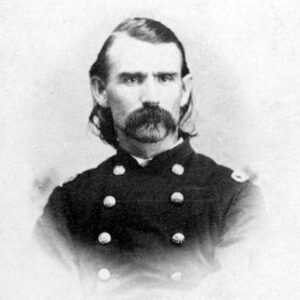calsfoundation@cals.org
Skirmish between Fayetteville and Cane Hill (November 9, 1862)
aka: Skirmish at Cane Hill (November 9, 1862)
aka: Skirmish at Fayetteville (November 9, 1862)
| Location: | Washington County |
| Campaign: | Prairie Grove Campaign |
| Date: | November 9, 1862 |
| Principal Commanders: | Colonel William F. Cloud (US); Colonel Emmett MacDonald (CS) |
| Forces Engaged: | Second Kansas Cavalry, Sixth Kansas Cavalry, Second Ohio Cavalry, First Indian Home Guard, Second Indiana Light Artillery (US); Colonel Emmett MacDonald’s Missouri Provost Guard (CS) |
| Estimated Casualties: | None (US); 1 killed, 6–30 captured (CS) |
| Result: | Union victory |
The Skirmish between Fayetteville (Washington County) and Cane Hill (Washington County) occurred on November 9, 1862, when General James Gilpatrick Blunt ordered Colonel William F. Cloud, Second Kansas Cavalry, to take a large reconnaissance force south and locate scattered Confederate picket and troop positions.
Left to watch aggressive Confederate movements in northwest Arkansas, after numerous encounters with Southern troops in October, Gen. Blunt kept his cavalry constantly moving. The Second and Third divisions of the Army of the Frontier returned to camps near Springfield, Missouri, after the October skirmishing. Alone in the field with the First Division, Blunt served as the forward observation post of the Army of the Frontier. On November 7, from his position at Camp Bowen in western Benton County, Blunt directed Col. Cloud to take a large mounted force and ascertain Confederate troop positions as far south as Fort Smith (Sebastian County), if possible. About fifteen miles south of Camp Bowen, Cloud discovered a tannery with more than two dozen vats of nearly finished leather, intended for Confederate use. All the leather and buildings were destroyed.
Continuing south, Cloud’s column met a detachment of Colonel Emmett MacDonald’s Confederate Provost Troops near the William Graham house, on the outskirts of Cane Hill. A few shots were exchanged, and the Confederates fled. Farther south of Cane Hill, Cloud’s cavalry came upon the main body of Col. MacDonald’s Missourians attempting to move a small baggage train. In the ensuing fight, the Confederates lost most of their supply wagons, and their flag, to the Kansans. Having no teams to haul away the captured wagons, Cloud’s troops burned them. The Confederate color bearer proved the only official casualty. However, the captured Confederate flag did “Federal duty” on the return to Camp Bowen, as Colonel Cloud decided to unfurl and fly it at the head of his column as they moved through the countryside. He suspected that some independent Southerners, or even regular Confederate troops, might approach and judge that they were among friends by the sight of the Confederate flag. Cloud’s suspicions proved correct, with several men coming forward to announce their Southern allegiance. All were taken prisoner. The exact number captured varies, depending on which source is used.
For additional information:
Crawford, Samuel J. Kansas in the Sixties. Ottawa: Kansas Heritage Press, 1994.
McMahan, Robert T. Reluctant Cannoneer: The Diary of Robert T. McMahan of the Twenty-fifth Independent Ohio Light Artillery. Edited by Michael E. Banasik. Iowa City: Camp Pope Bookshop, 2000.
Osborne, Vincent B. “Vincent B. Osborne’s Civil War Experiences—Part Two: September, 1862–July, 1865.” Edited by Joyce Farlow and Louise Barry. Kansas Historical Quarterly 20 (August 1952): 187–199.
Scott, Kim Allen, and Stephen Burgess. “Pursuing an Elusive Quarry: The Battle of Cane Hill, Arkansas.” Arkansas Historical Quarterly 56 (Spring 1997): 26–55.
The War of the Rebellion: A Compilation of the Official Records of the Union and Confederate Armies. Series I, Vol. 13, p. 358. Washington DC: Government Printing Office, 1885.
Stephen Lee Burgess
Rogers, Arkansas
 Civil War Timeline
Civil War Timeline Military
Military ACWSC Logo
ACWSC Logo  William Cloud
William Cloud 




Comments
No comments on this entry yet.